Long-Term Keepers: Three Watches I Can’t Bear To Sell
by GaryG
I don’t know about you, but for me these days if I want to buy a watch of any significance it requires that I sell one or more other pieces.
The bad news is that all of the watches I don’t really love were sold off a long time ago! As a result, the discipline of asking, “what watch in my current collection do I love less than this potential new purchase?” has become tougher and tougher.
There are several watches that I’ve owned for many years that don’t get much wrist time and might be candidates – but for the three watches below, the combination of their horological significance and my personal attachment to them are likely to keep them firmly rooted in my collection for a long time to come.
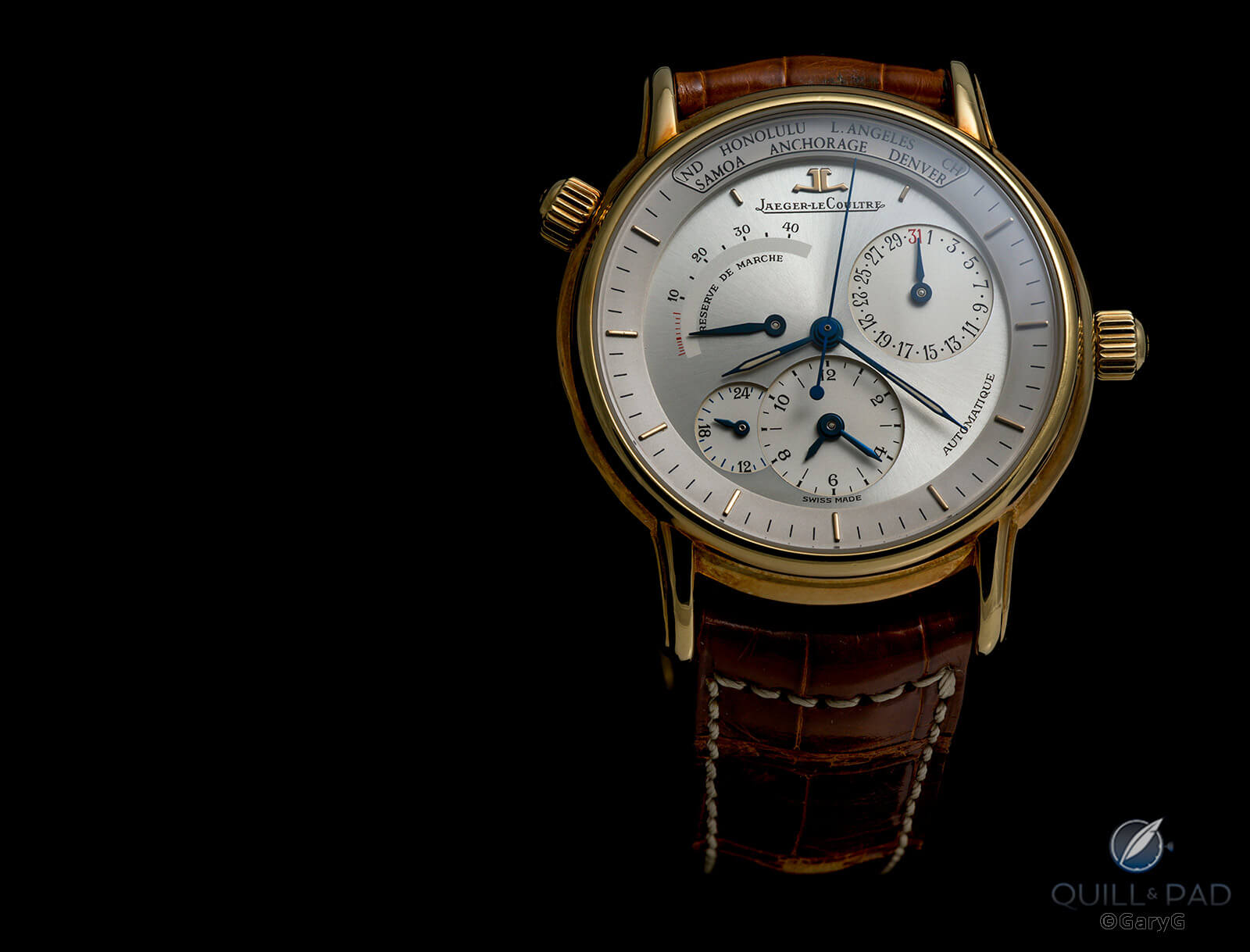
Jaeger-LeCoultre Géographique, first generation in yellow gold
1. Jaeger-LeCoultre Géographique Reference 169.1.92
The story: By the early 1990s, I’d started to travel regularly on business, including travel abroad requiring connection stopovers at major airports with their alluring displays of watches. At this point I’d bought my first Jaeger-LeCoultre piece, the original Reverso Duoface in stainless steel, and pretty much memorized the available JLC product brochures and collection catalogs. On my travels I made it a habit to peer through the glass of the duty-free shop cases at everything Jaeger-LeCoultre related.
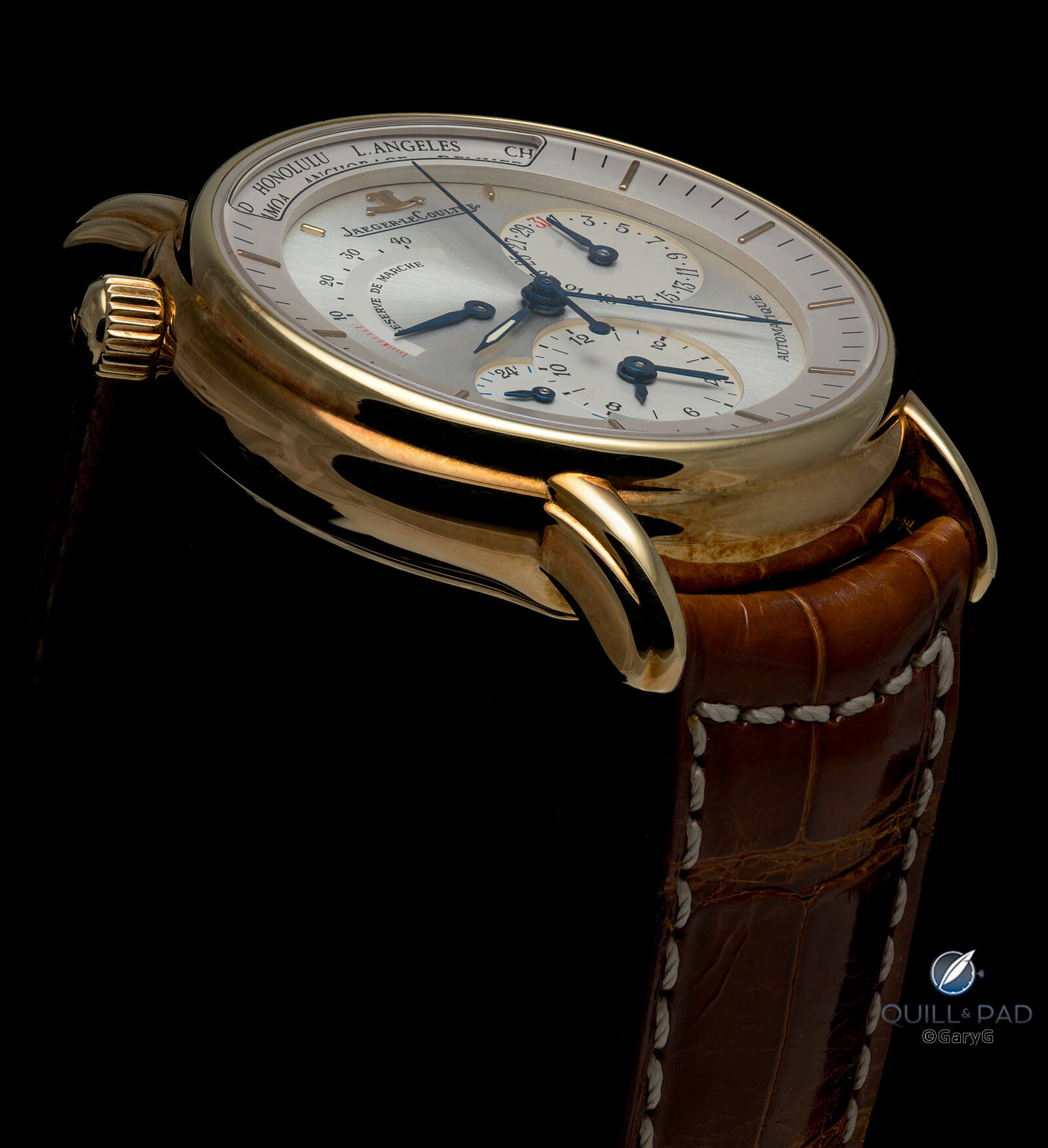
The author’s Jaeger-LeCoultre Géographique
When the Géographique was introduced in 1996, I was gobsmacked: I loved both the look of the watch and the technical innovation incorporated. A small clutch and gear train that disconnected the hands of the second time zone and the peripheral city disk from the running movement just long enough to allow the cities to be clicked forward or back with a crown was to me absolutely in the tradition of Jaeger-LeCoultre as the industry’s movement innovator.
Like any suitable object of desire, this one was beyond my rational ability to buy at the time; but as fate would have it, during a flight change in Brussels I stumbled across a sign declaring “10 percent discount sale!” on Jaeger-LeCoultre watches. I did some quick exchange rate figuring, and just like that the watch was on its way home with me, subsequently rotating with the Reverso Duoface as my daily wearer for the better part of a decade.
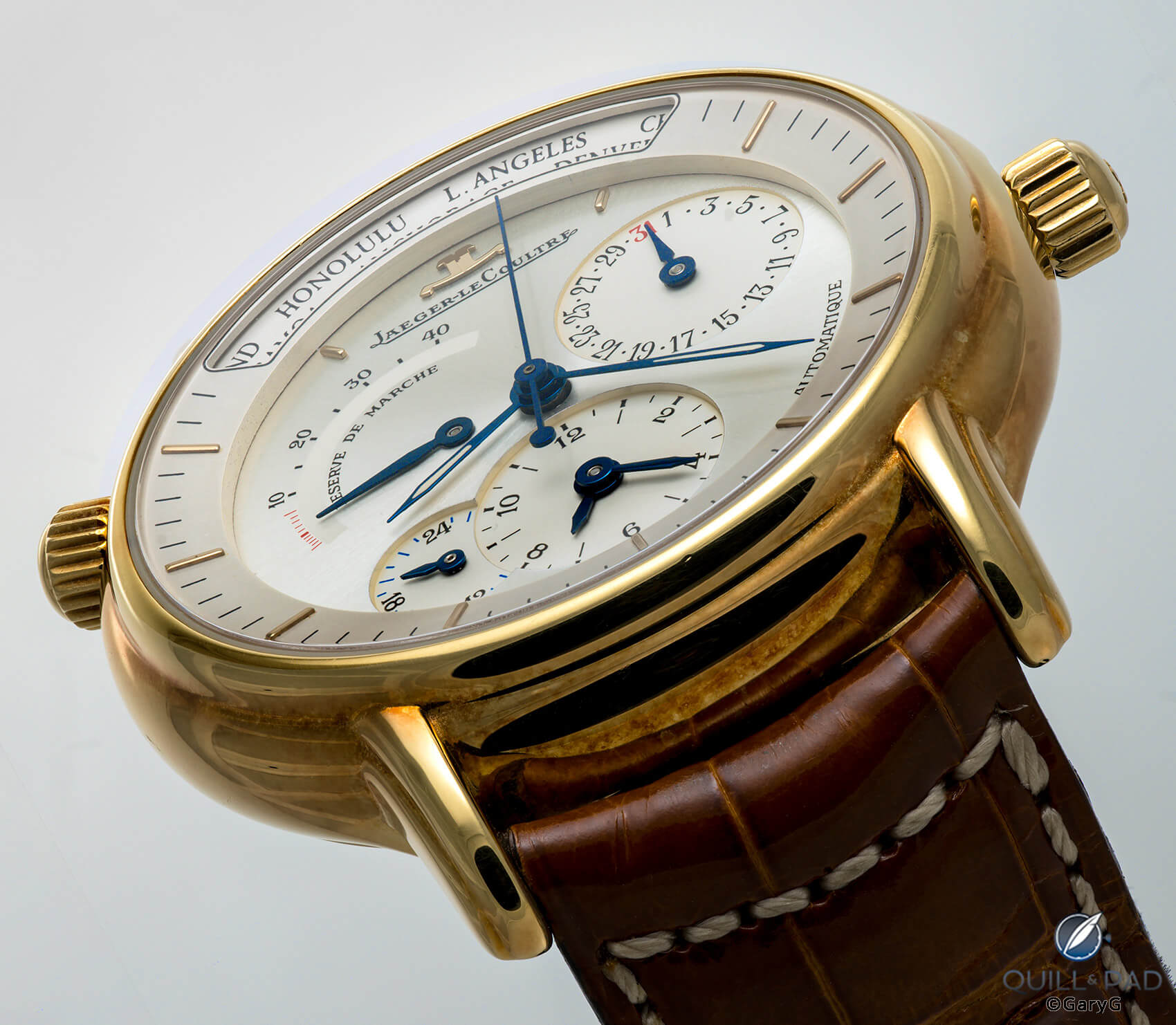
First-generation Géographique by Jaeger-LeCoultre
Why it’s a keeper: First of all, like all of the watches I’ll be discussing, the Géographique and I have done a lot of miles together! And as mentioned earlier, the innovative design of the second time zone mechanism qualifies this watch as a foundational piece – one that can be a core element of an enduring collection.
There’s also something about the rounded shapes of the case and stepped lugs that really appeals to my eye, making this first-generation version more attractive than the Master Geographic watches that have followed in its wake.
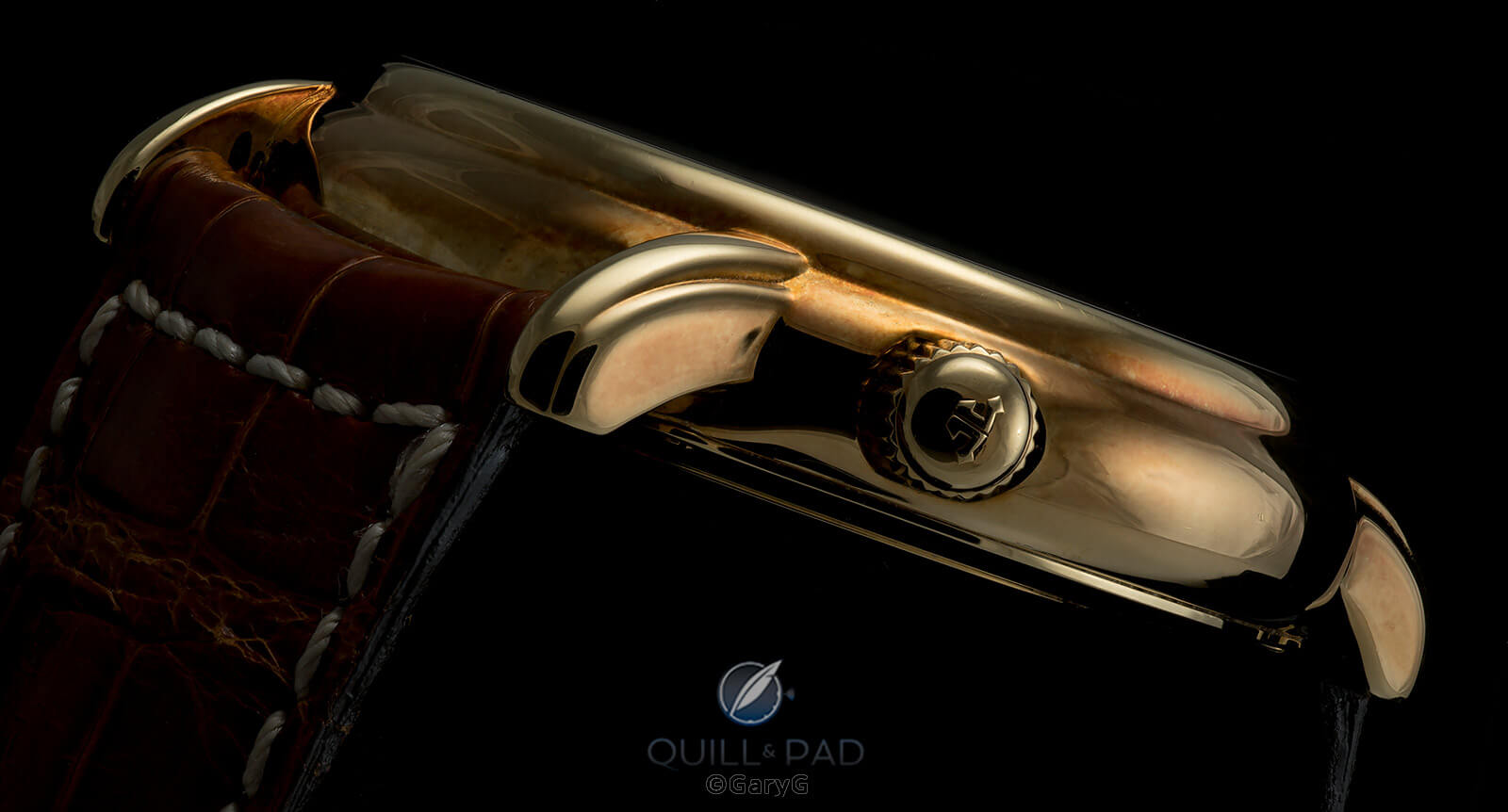
Rounded profiles and stepped lugs: Jaeger-LeCoultre Géographique
There are multiple other visual touches that I love, including the multi-layered dial, the applied batons, dark blued hands, and red and blue (take a close look at the printed indices on the 24-hour subdial) accents. And as more and more watches seem to employ subdial seconds displays, I’m reminded every time I wear this watch how much I enjoy a big, sweeping central second hand.
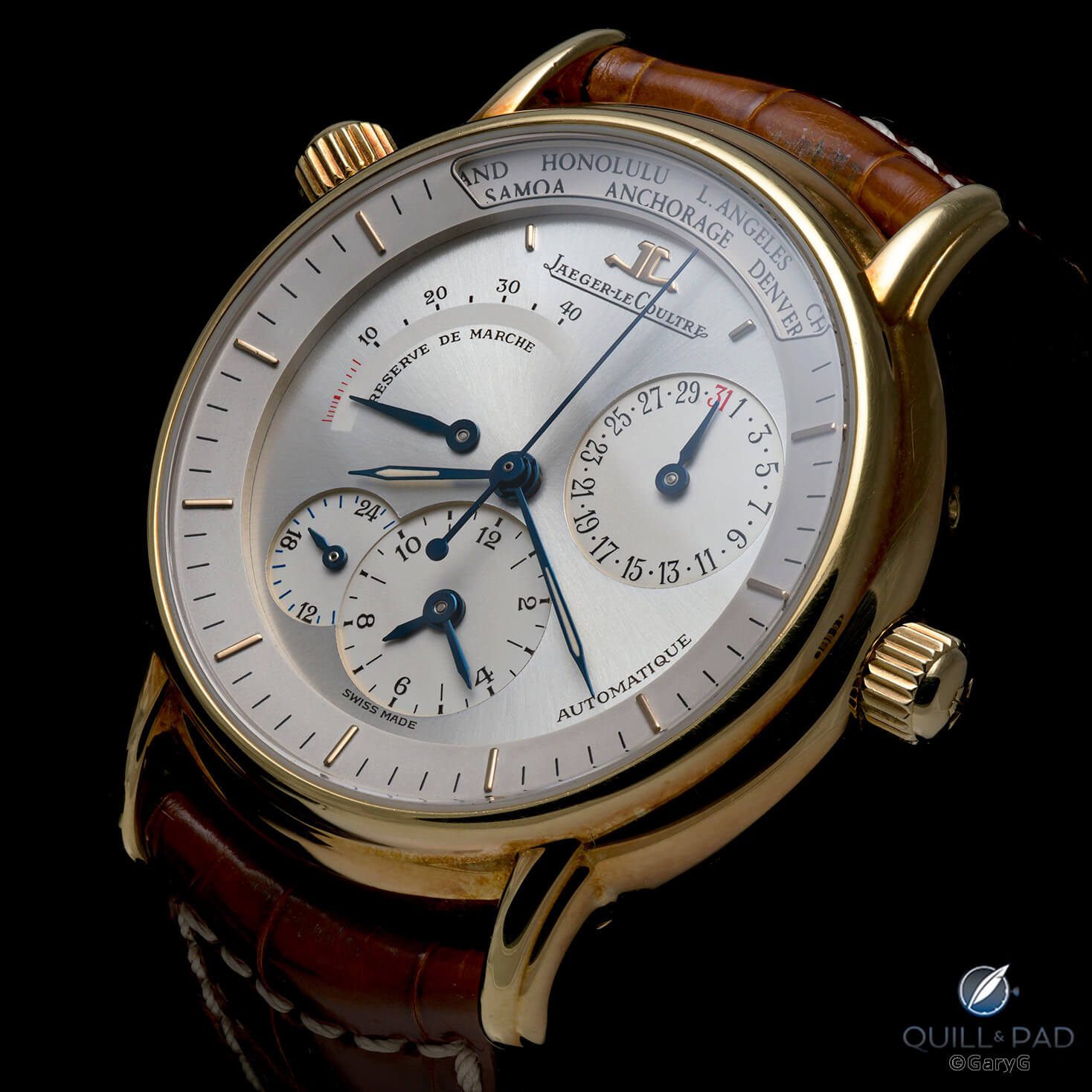
Dial side details, JLC Géographique
If the dial side layout looks familiar to you, you shouldn’t be surprised: Caliber 929/3 and its successors were used by brands from Vacheron Constantin and Audemars Piguet to Ralph Lauren, and its asymmetric display of second time zone, date, and power reserve is instantly recognizable.
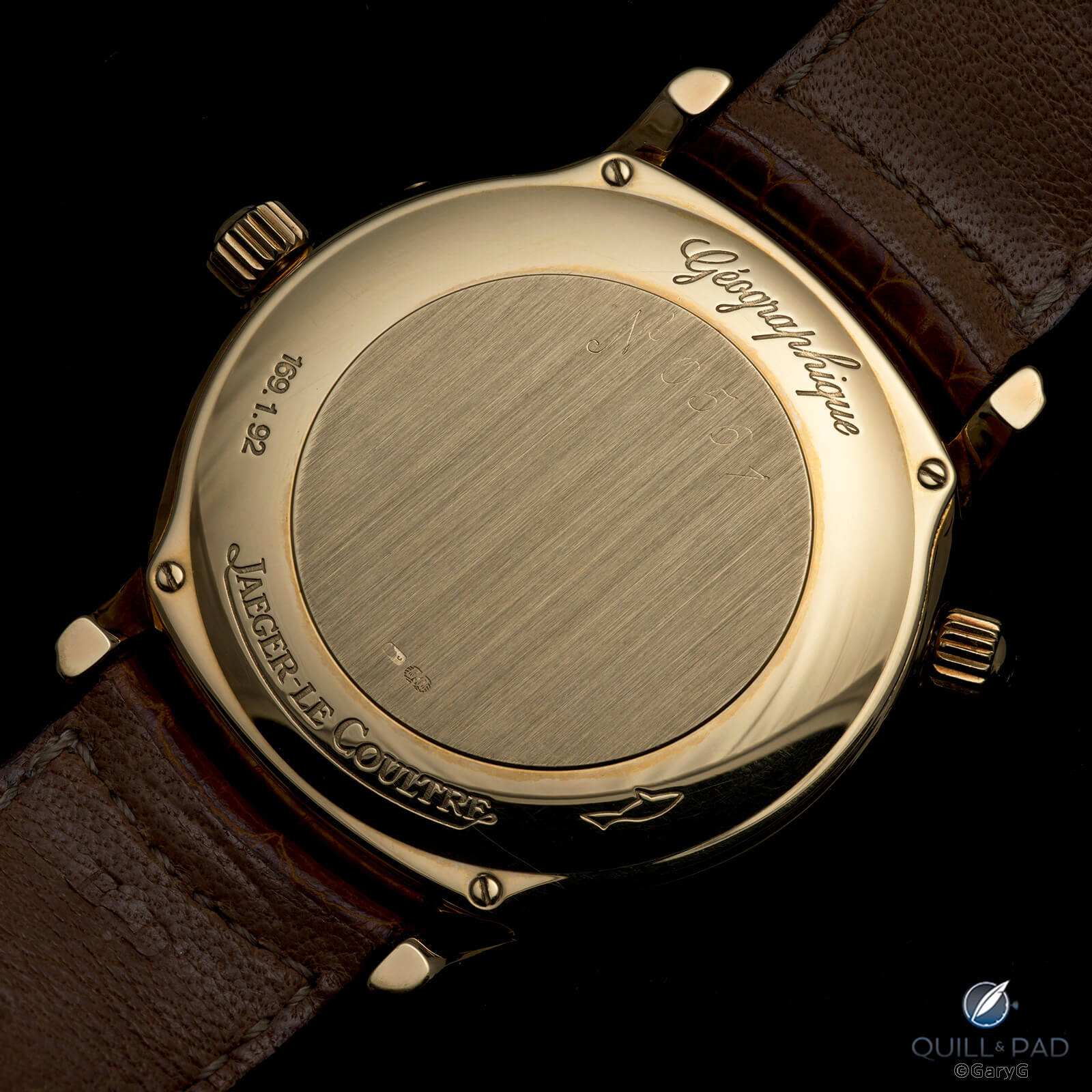
Nothing to see here: closed caseback, JLC Géographique
Caliber 929/3 is concealed on the yellow gold version behind a solid case back, so there’s nothing to show; but when it comes to timekeeping, this movement is perhaps the most accurate I’ve ever owned. Here’s a look at the timing slip that accompanied the watch back from a routine service.
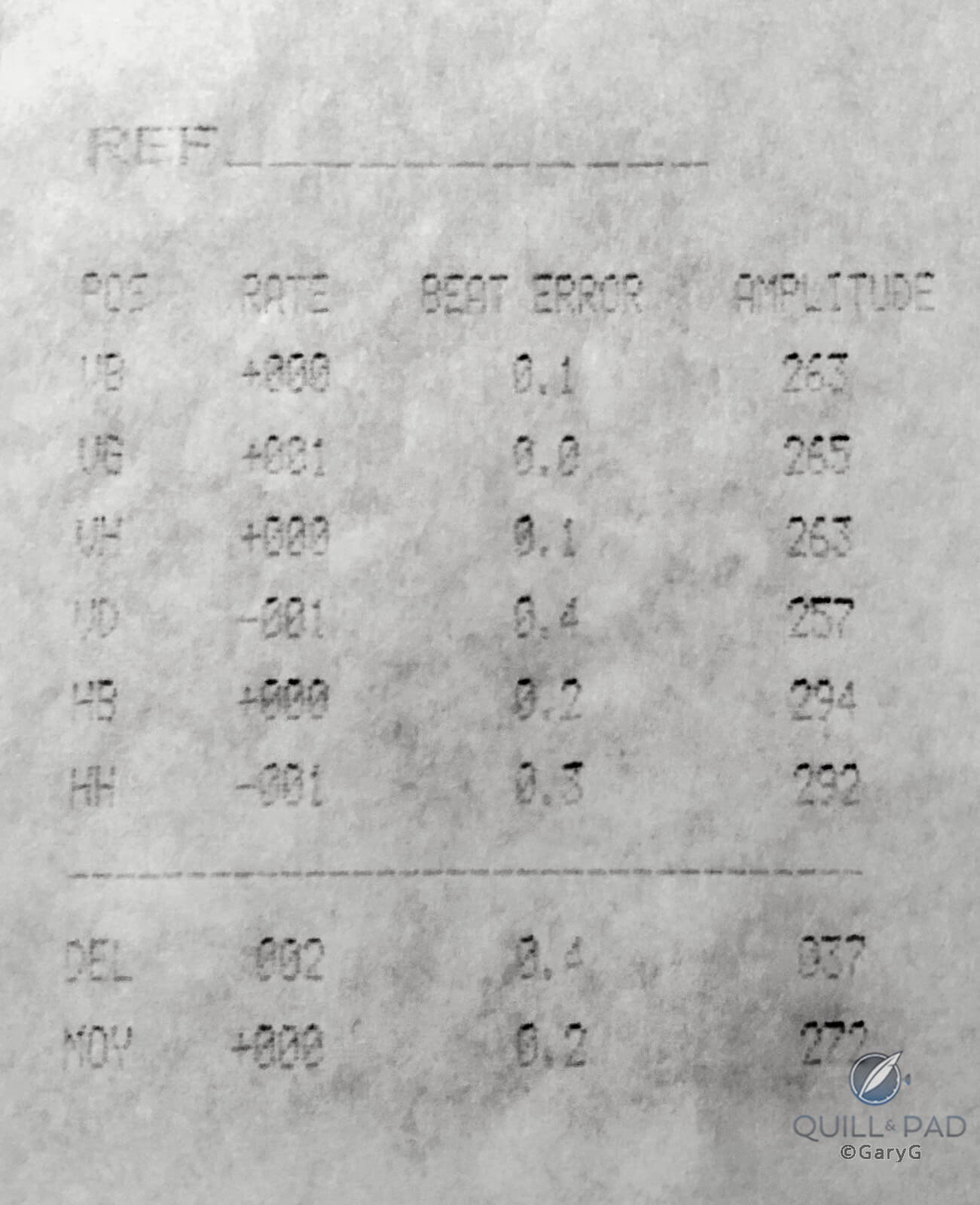
Zeroes and ones: the greatest timing slip in history?
That performance hasn’t diminished over time, either: I keep the Géographique on a winder, and even after months in the back corner of the safe the time is bang-on when I fish the watch out for some well-deserved wrist time.
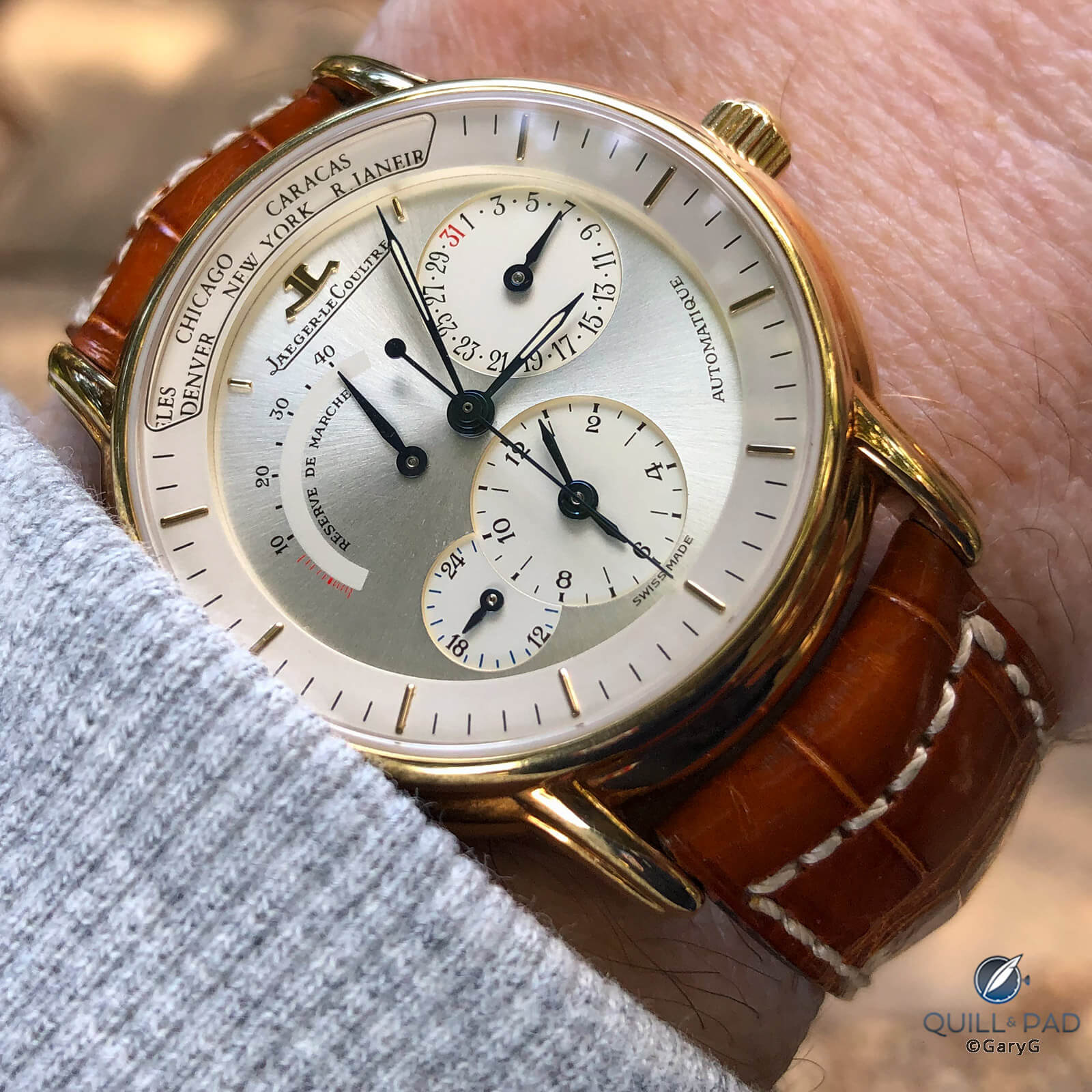
On the wrist: first-generation Jaeger-LeCoultre Géographique
2. Audemars Piguet Jules Audemars Equation of Time
The story: You can imagine that if I found the clutch mechanism of the Géographique impressive, my brain almost melted when in my early days on the watch forums I happened across posts about the Jules Audemars Equation of Time.
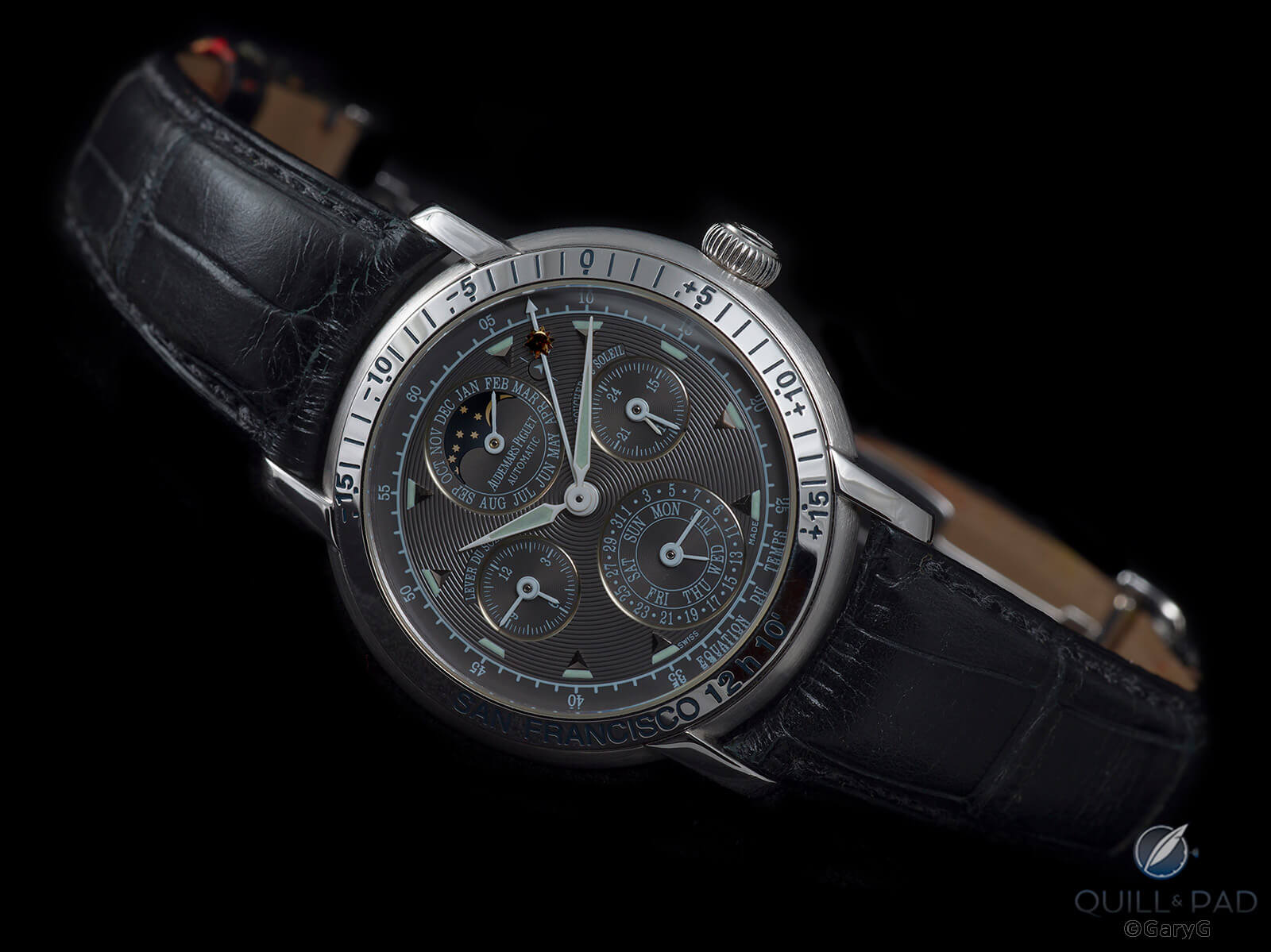
Audemars Piguet Jules Audemars Equation of Time in white gold
I immediately started poking around to see if I could find one pre-owned, and in the process met one of my closest friends who owned (and still owns) an example of the white gold version you see above.
But it was by the sheerest of coincidences that during a visit to our local independent-oriented watch store I happened to mention that I was lusting after an EOT, only to be told that they had just taken one in trade, had it in the back room, and were offering it at a price that I thought seemed too good to be true. There was one hitch: the watch required servicing in Switzerland and I’d have to commit to buying it before it was sent off. I took the plunge and haven’t looked back.
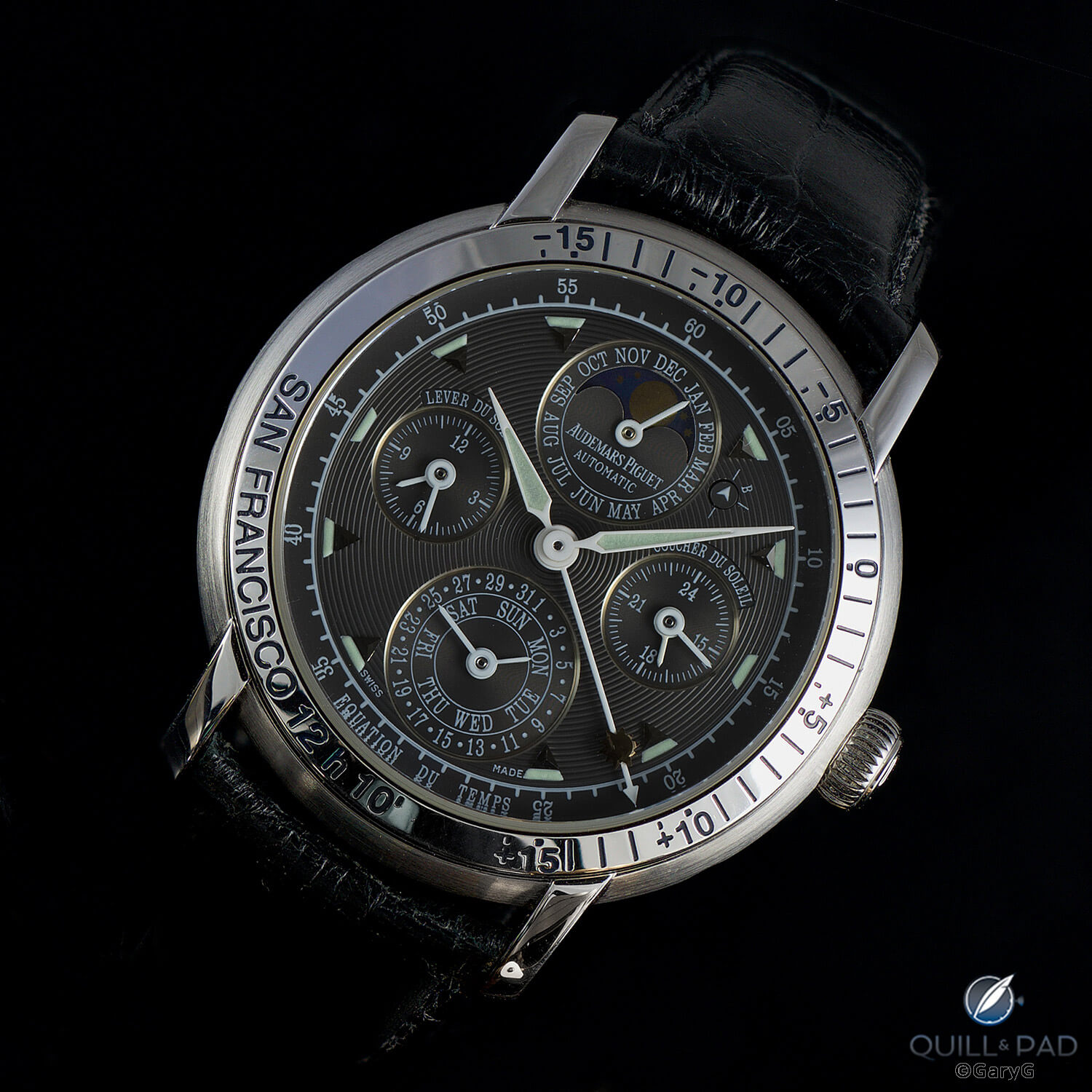
Mechanical marvel: Jules Audemars Equation of Time
Why it’s a keeper: Automatic winding, perpetual calendar, moon phase, equation of time, indicated time of solar noon, and local times of sunrise and sunset, all delivered through an assortment of gears, springs, and cams. What’s not to love?
I’m fully prepared to argue that as a matter of objective fact the EOT is one of the very few greatest wristwatches ever made. It’s a continuing mystery to me why its value in the resale market has been so low for so long, with the exception of the localized nature of some of the indications and the need for a fairly expensive cam-and-bezel switch to change locations.
For me, the watch is remarkable enough on its own merits that I won’t care even if I do move somewhere else.
The powerhouse behind this performance is Caliber 2120/2808, based in turn on the legendary ultra-thin automatic 2120 movement developed as the Caliber 920 ebauche by (who else) Jaeger-LeCoultre and utilized by AP as the 2120, Vacheron Constantin as the 1120, and Patek Philippe as Caliber 28-255.
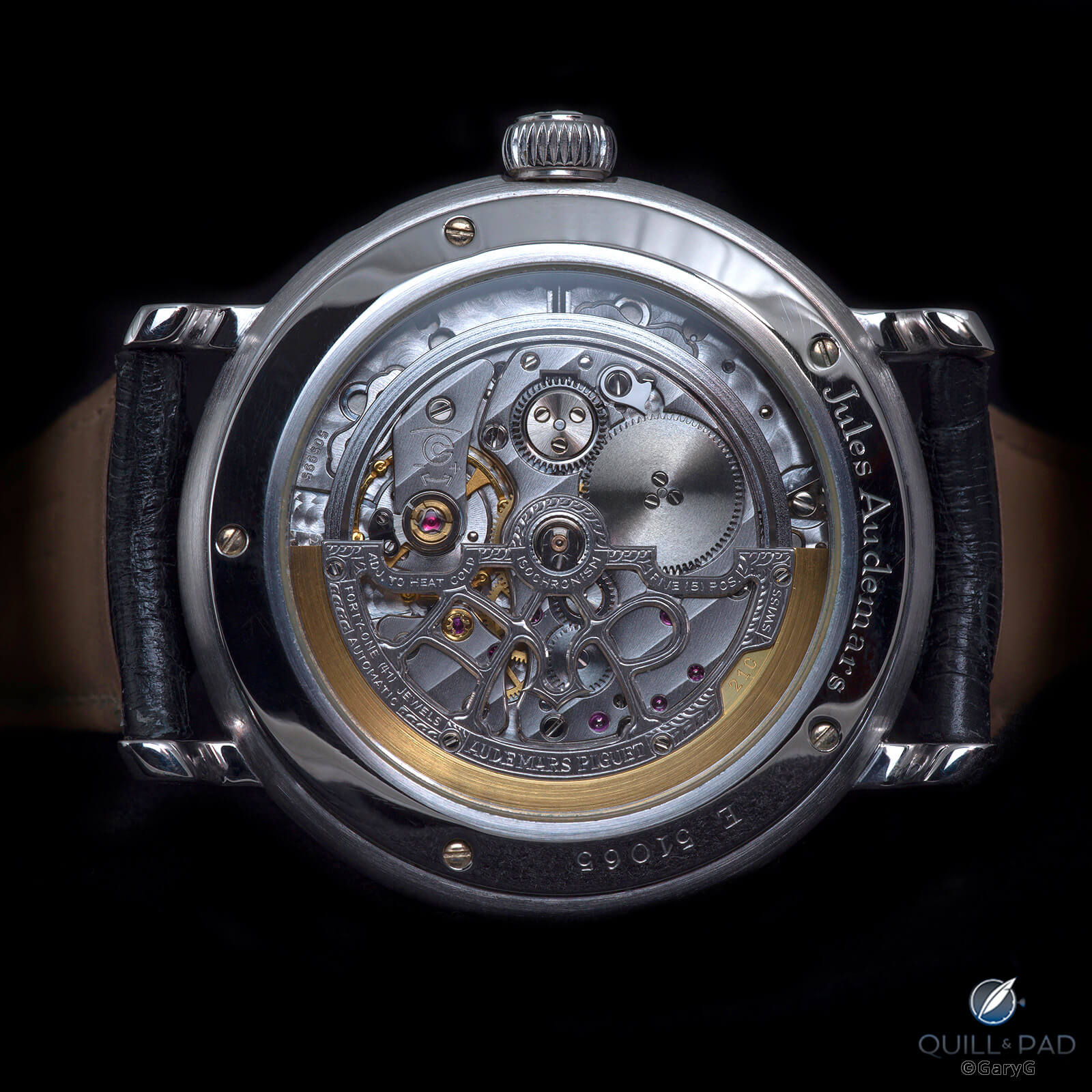
Brilliant mechanics, beautiful execution: Audemars Piguet Caliber 2120/2808
The hand-engraving on both the rotor and case back are pluses for me, and if I feel an irresistible urge at some point, it’s possible to have a custom rotor made with one’s own initials or another pattern. A good friend of mine notes that he’s saved big money over the years by having the first initial A and marrying someone with first initial P. I’m not quite so fortunate!
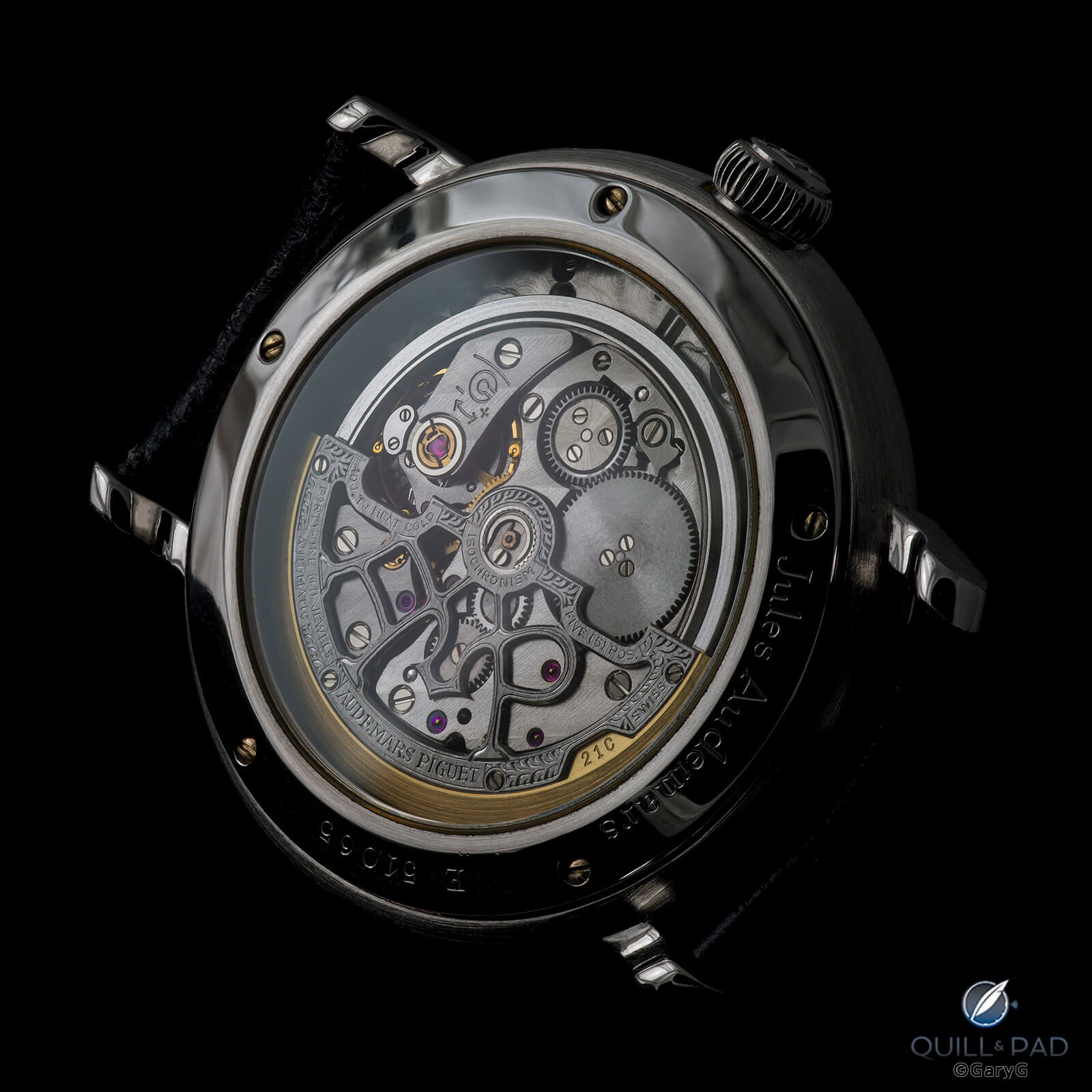
Movement view, Audemars Piguet Equation of Time
One more neat thing about this movement family is the unique sound that the beryllium ring supporting the winding rotor makes when it passes over the ruby rollers beneath it. I’ll confess that if I had to choose one automatic movement to put at the top of my list, this would be the one.
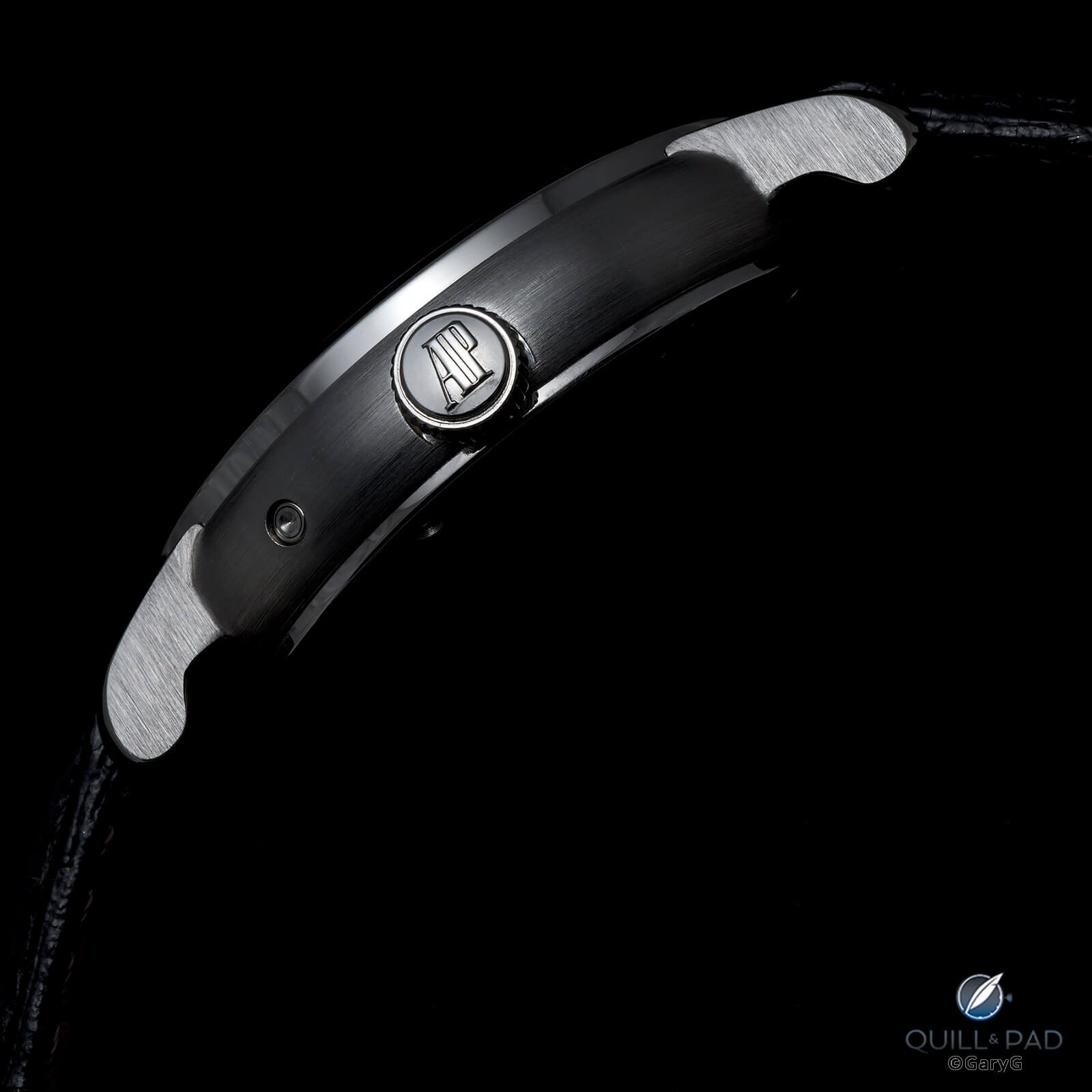
Jules Audemars case profile
I am a fan of the Jules Audemars case, with its classic profile and effective use of contrasting brushed and polished areas; and even the AP-shaped deployant buckle brings a smile when taking this watch on and off the wrist.
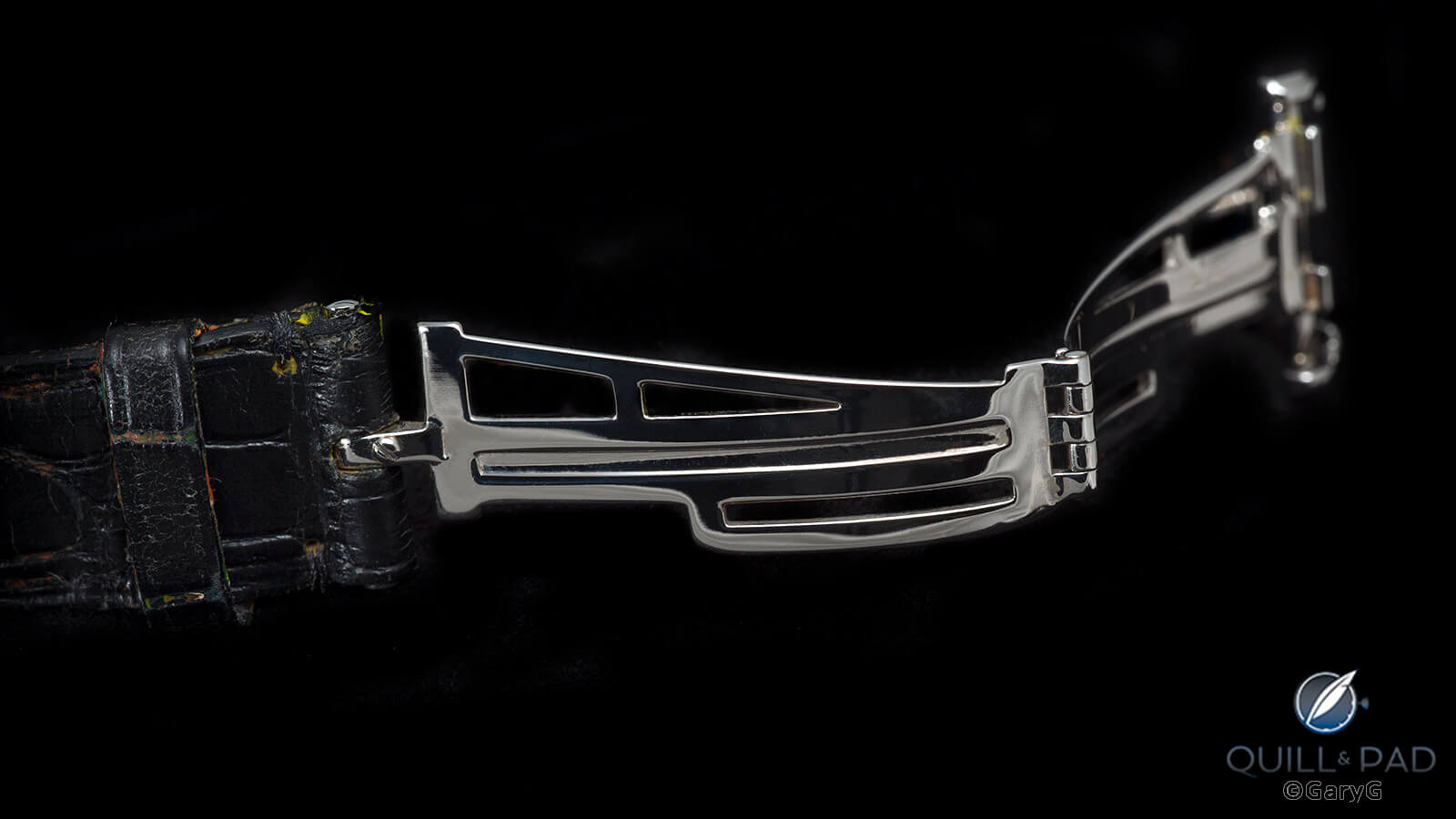
If only my initials were AP: Audemars Piguet deployant buckle
Those traces of paint that you see on the strap in the photo below? Remnants of this watch’s role in one of the great events of my life, my commission with artist Alexa Meade during which she painted her impression of the watch atop the plastic-wrapped piece.
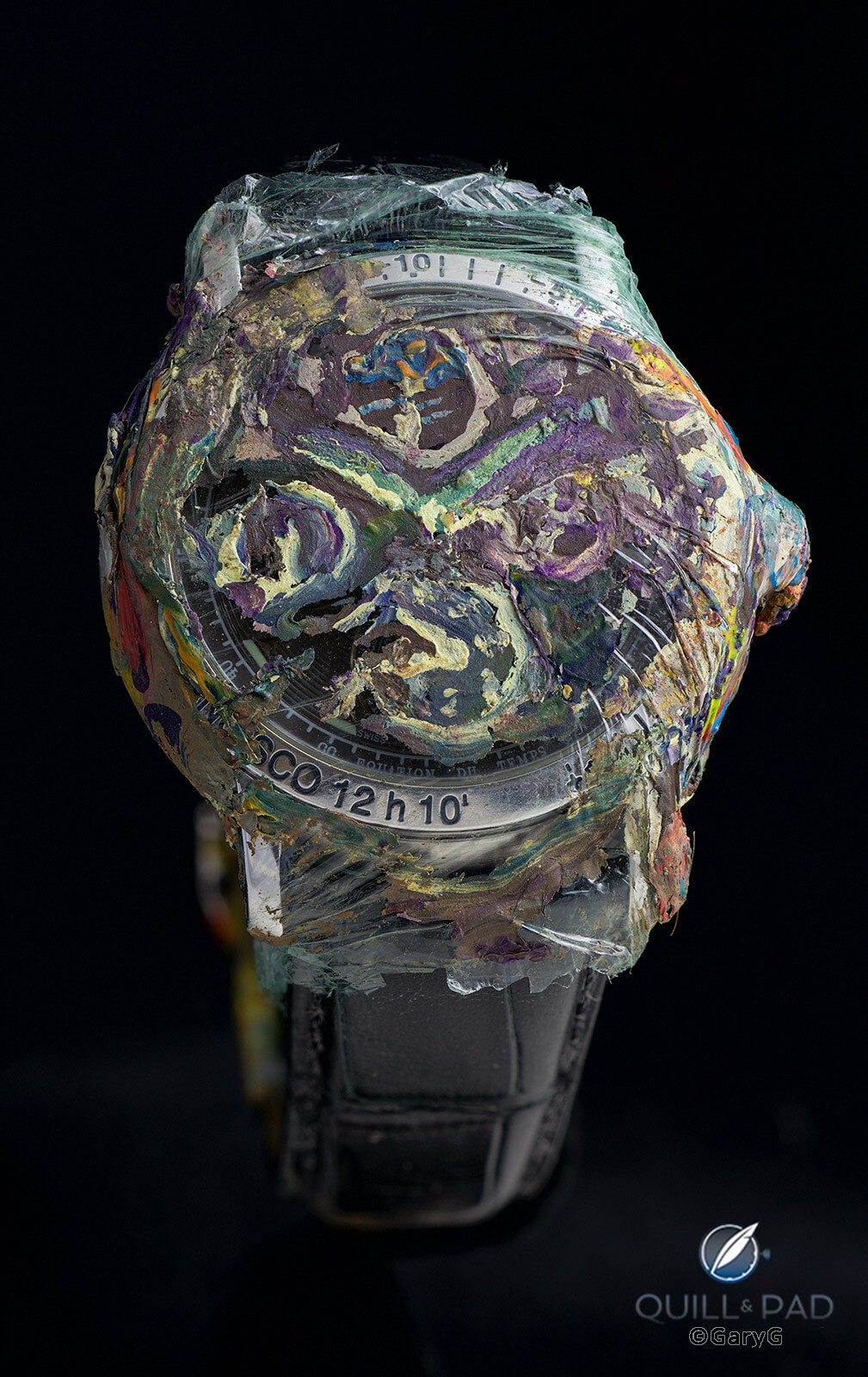
Jules Audemars Equation of Time as painted by Alexa Meade, a bit weary looking following a full day of shooting
I have the plastic wrap carefully stored and the watch is back to its original appearance, but if I needed any more motivation to classify it as a keeper, its ability to bring that day with Meade back to life each time I wear it certainly suffices.
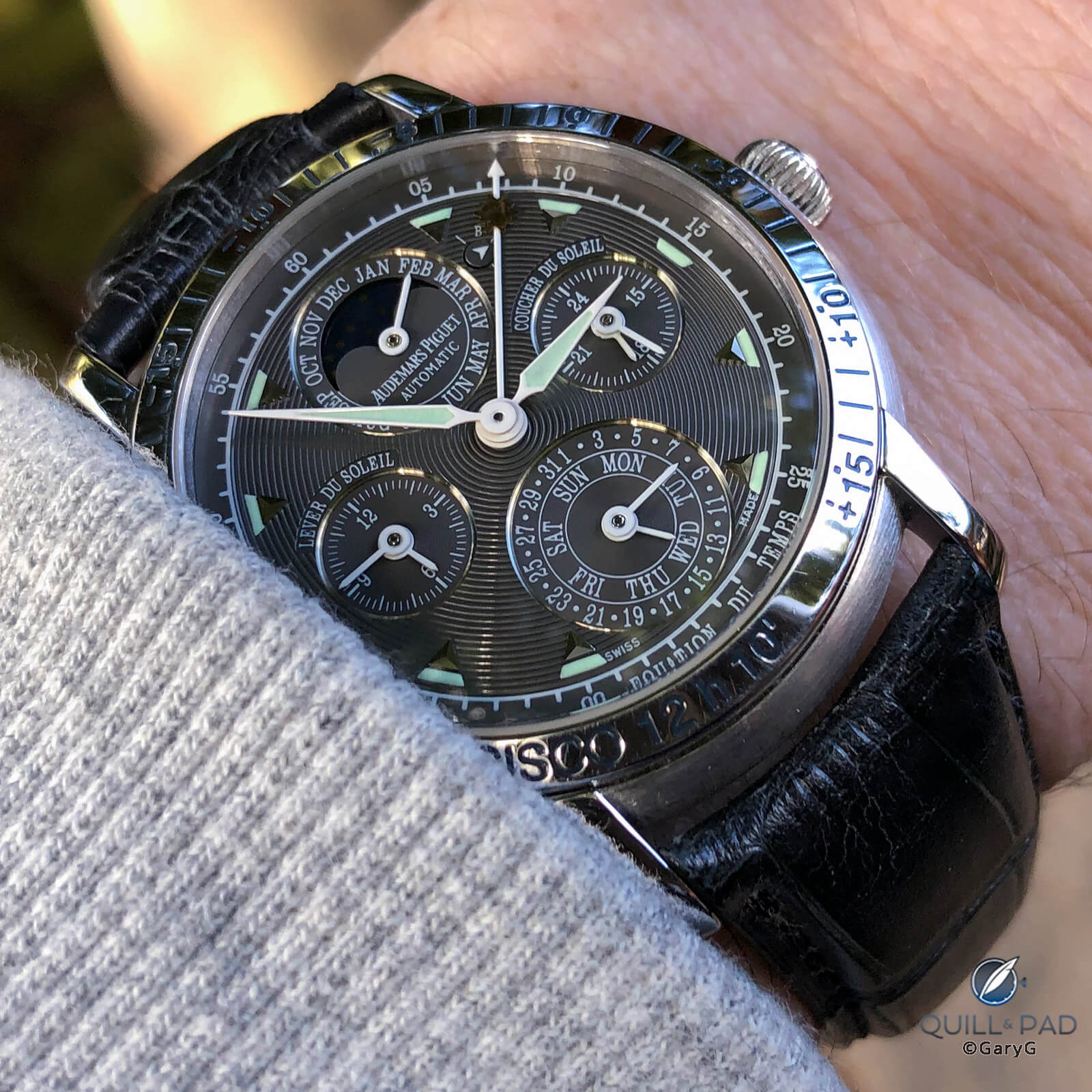
On the wrist: Audemars Piguet Jules Audemars Equation of Time
3. Jaeger-LeCoultre Master Ultra Thin Reference 145.8.79.S
The story: DrMrsG and I hadn’t been married that long, but it was already evident to her that I was crazy for all things horological and as a “big” birthday gift she proposed that I select a watch that would be meaningful to me.
Of course, any watch purchased by one’s partner is going to have real meaning! I thought long and hard as I didn’t want to break the bank but at the same time wanted to pick a piece that had real merit. Given the options I considered I’m still really pleased that I landed on this early Master Ultra Thin.
One immense influence on my decision was a landmark 2002 review on TimeZone by Walt Odets, a professional psychologist and noted author and self-taught watchmaker. Odets may well have invented the in-depth online watch review, and he went to lengths we can barely imagine these days, actually taking the watches apart and re-assembling them while capturing their features in carefully annotated photos and unsparing prose.
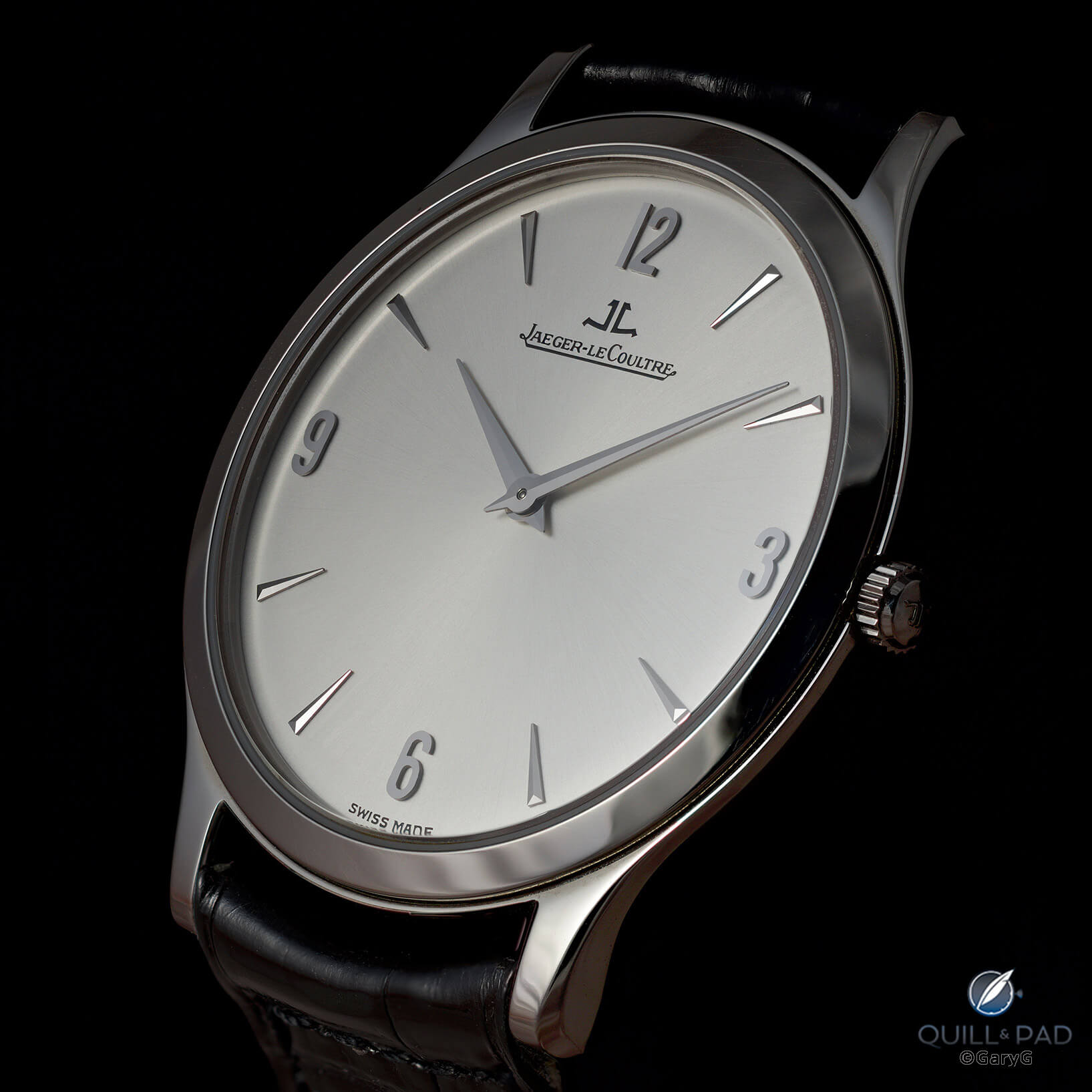
Master Ultra Thin by Jaeger-LeCoultre
Why it’s a keeper: DrMrsG has sold a couple of watches that I’ve gifted to her (after discussing the idea with me), but I’m perhaps not so brave! Brave or not, I’d probably still have kept this piece: as Odets noted in his review, the Master Ultra Thin with its Caliber 849 was one of the greatest ultra-thin watches of its time. Despite ongoing innovation in the ultra-thin stakes by Piaget, Bulgari, and others, I believe that it still acquits itself extremely well.
Caliber 849 (a minor update from Caliber 839, originally introduced in the 1970s) has a number of features including a hanging spring barrel to keep it thin and utilizes pillar-and-plate box-like construction to ensure its rigidity.
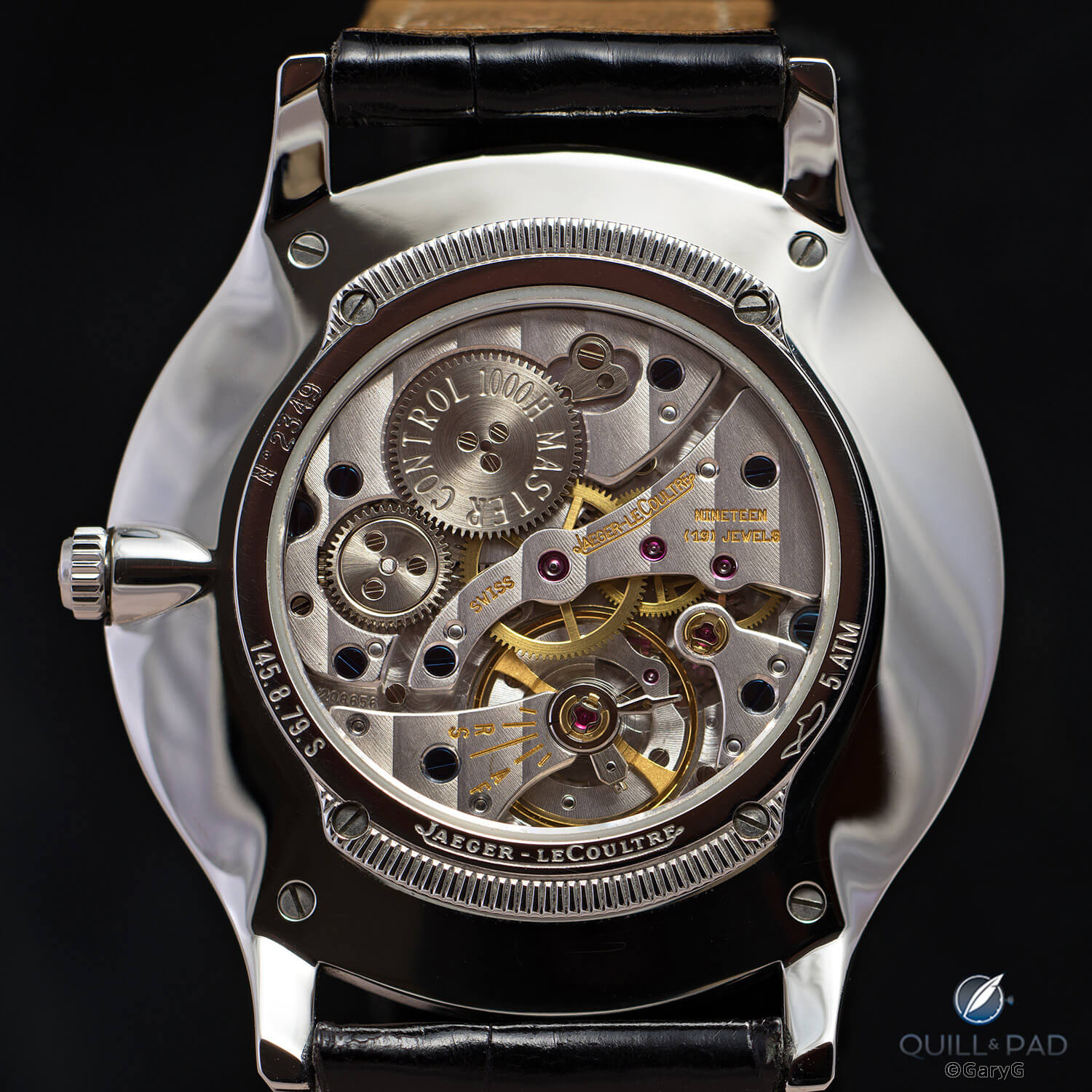
Movement view, Jaeger-LeCoultre Master Ultra Thin
It was said at the time that the Master Ultra Thin and its movement were finished and assembled in JLC’s Complications Department, a claim that I find easy to accept given the attractive finishing work and the obvious challenges inherent in making a robust watch this thin.
As proud owners drolly noted in comparing the Master Ultra Thin with other brands’ thin watches, which ground to a halt when strapped a bit too tightly onto the wrist, the Master Ultra Thin might not have been absolutely the thinnest watch in the world, but it was the thinnest one that worked.
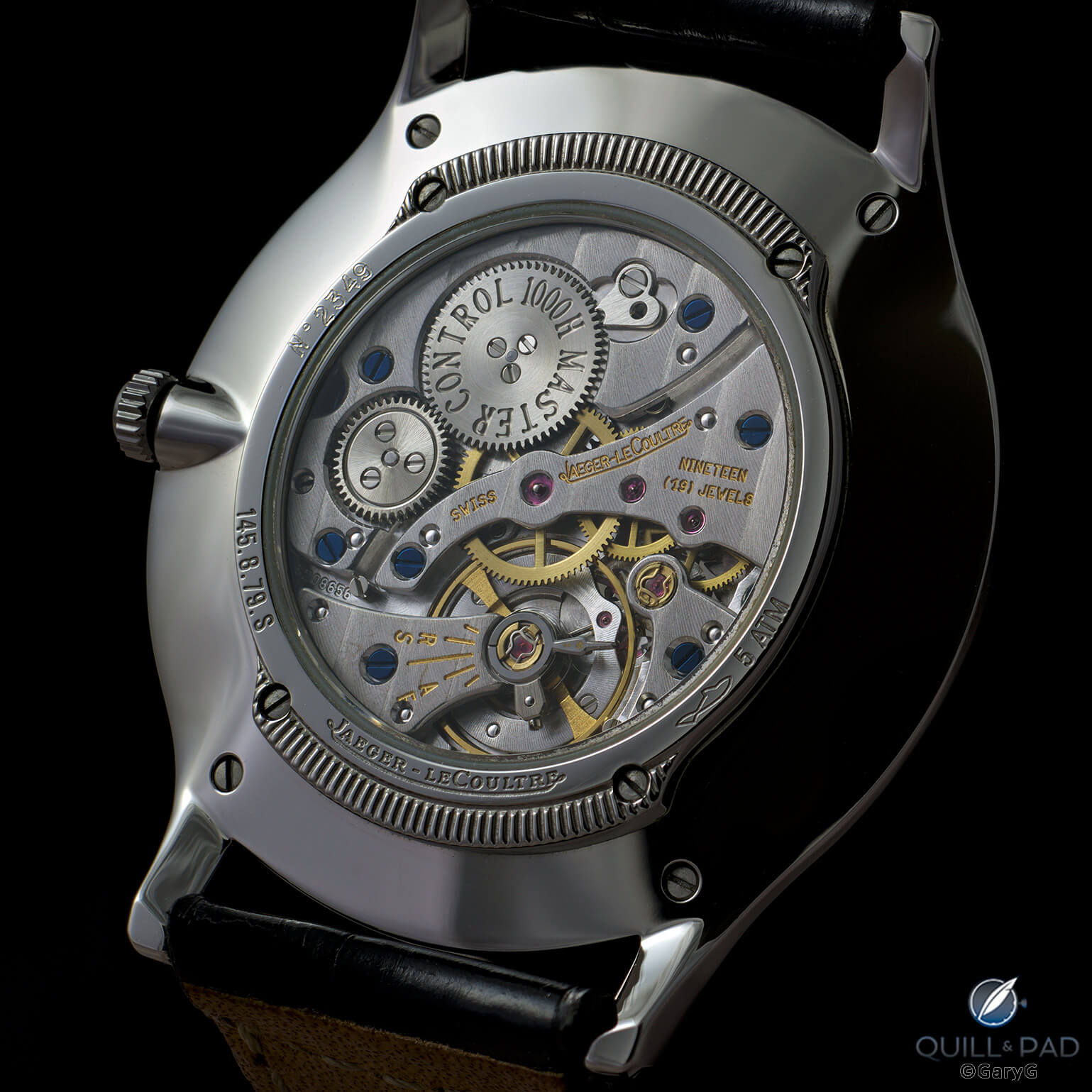
High complication quality: Jaeger-LeCoultre Caliber 849
The case integrity is such that the watch is pressure-rated to 5o meters (5 ATM), and while there was an even marginally slimmer version made with a solid case back, I’m glad that I have the one that allows the movement and its classic Vallée de Joux finger-bridge architecture to be viewed.
Jaeger-LeCoultre even deployed an optical illusion to help make the watch both thin and attractive: while the hands appear to rise to a ridge in the center, they are actually flat. The illusion of vertical shape comes from polishing one side of the hands and frosting the other.
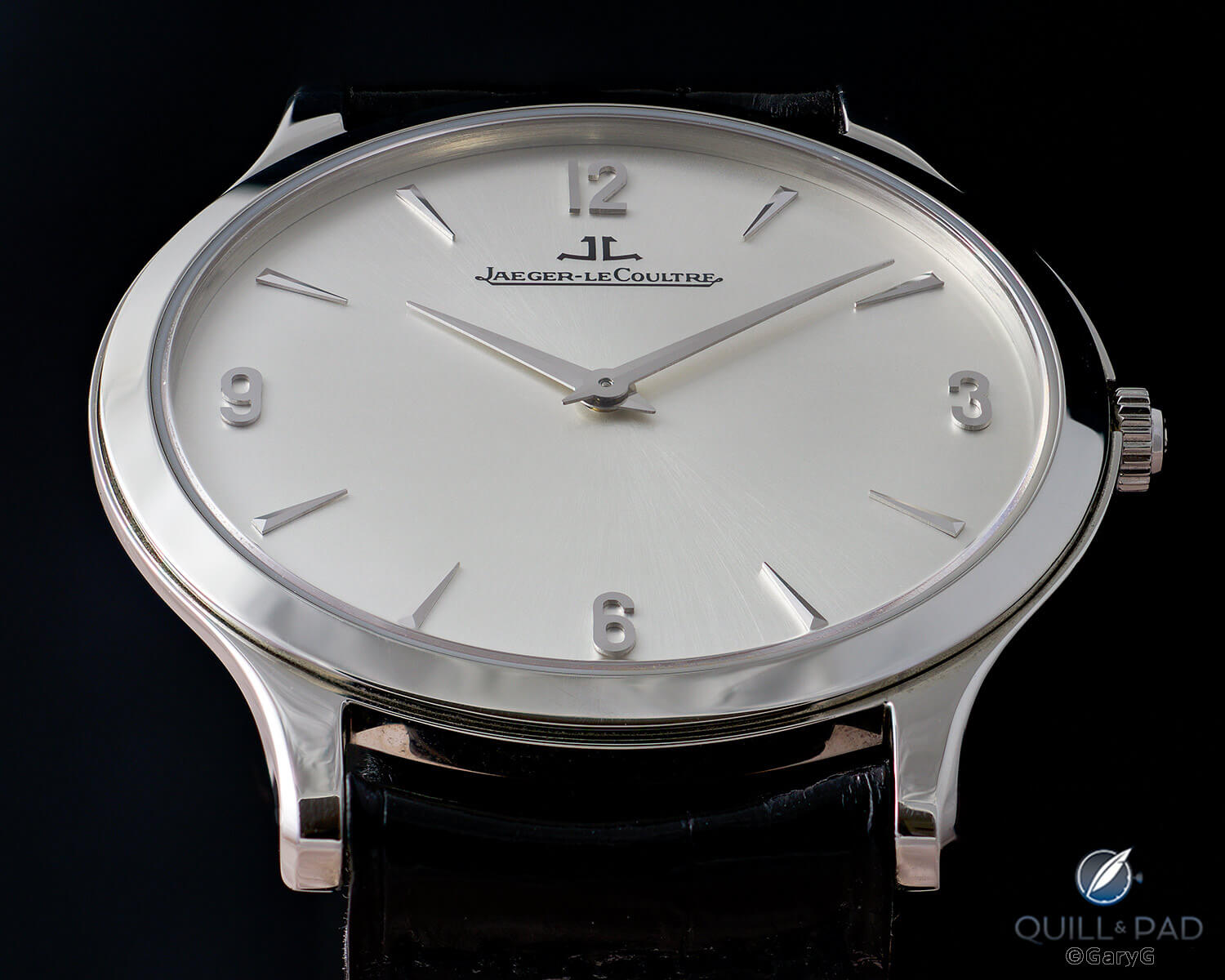
Illusion of depth: Master Ultra Thin with frosted and polished hand finishes
At 34 mm in diameter the Master Ultra Thin does wear a bit small on the wrist by contemporary standards. I’m tempted to say “but it wears bigger than it measures” just like every other review of smallish watches, but I’ll spare you that.
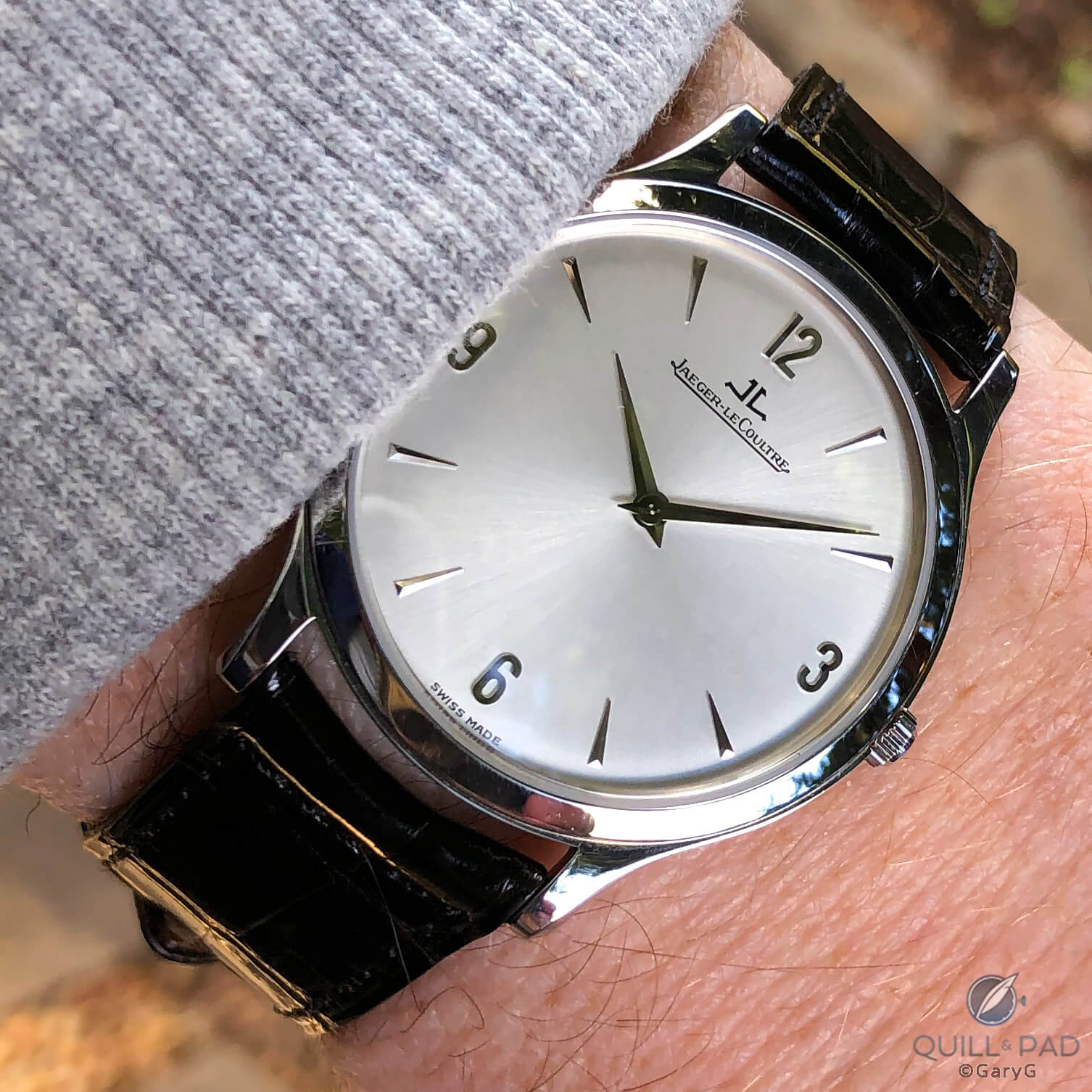
On the wrist: Jaeger-LeCoultre Master Ultra Thin
A three-watch collection?
Could I imagine living with these three watches as my only pieces? I’d hazard to say that I could do much worse: a versatile classic with interesting small complications, one of the great complicated watches ever seen, and a slim steel daily wearer that with a more casual strap could pretty much go anywhere. Perhaps one more addition like my vintage Omega Ploprof as a foul-weather watch would make the set complete – but we’ll have to come back to that another time.
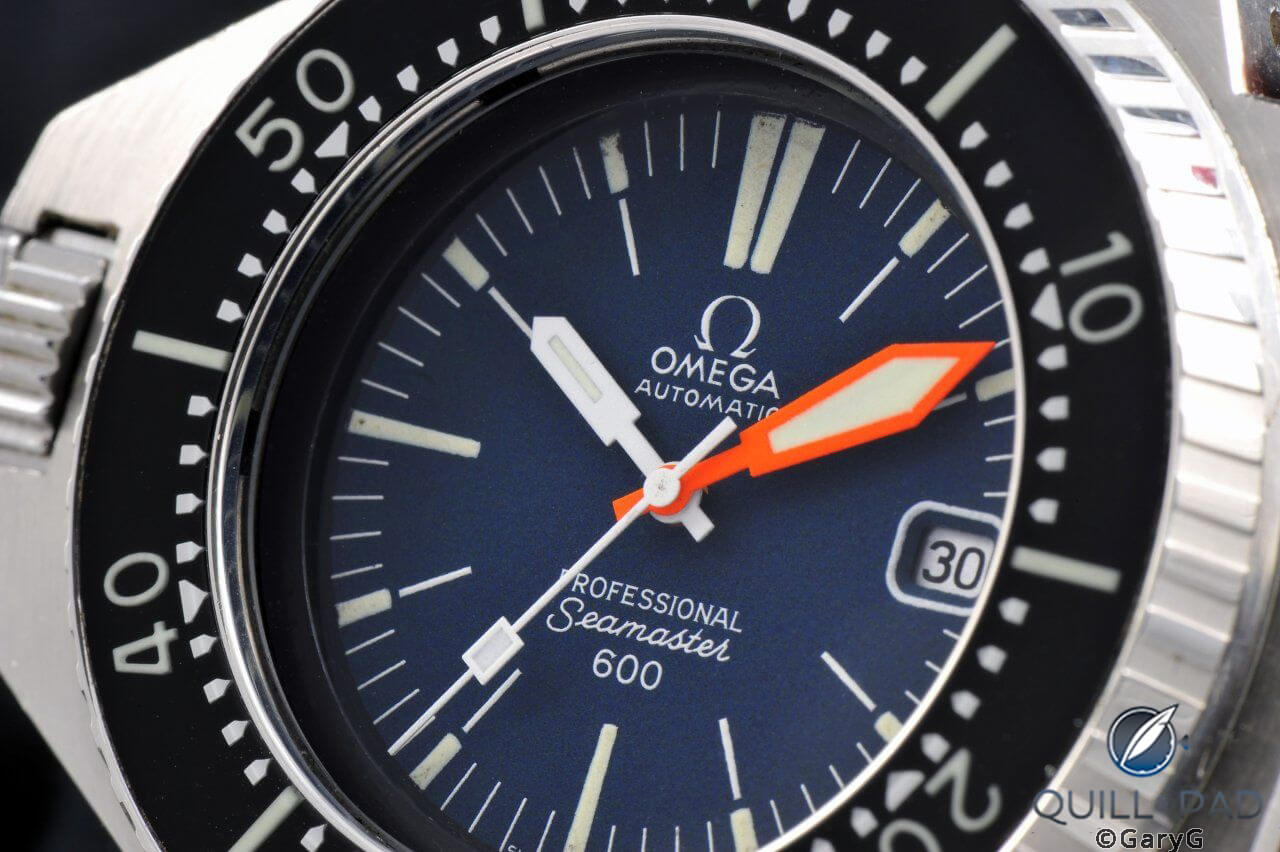
Parting shot: Omega Seamaster 600 Ploprof
I’m interested to hear about your long-term keepers in the comments section. In the meantime, happy wearing!
Approximate recent online market asking prices:
Jaeger-LeCoultre Géographique (first generation): $8,000 to $10,000
Audemars Piguet Jules Audemars Equation of Time (first generation): $25,000 to $28,000
Jaeger-LeCoultre Master Ultra Thin (first generation, sapphire crystal case back, deployant buckle): $4,000 to $5,000
* This article was first published 13 March 2021 at Long-Term Keepers: Three Watches I Can’t Bear To Sell
You may also enjoy:
Living Beyond Your Means As A Collector: How To Avoid Getting Hurt
Jaeger-LeCoultre: A Collector’s ‘Gateway Drug’ And Ongoing Pleasure
A Contemporary Watch Collector Goes Vintage With An Omega Seamaster Ploprof 600m



Leave a Reply
Want to join the discussion?Feel free to contribute!